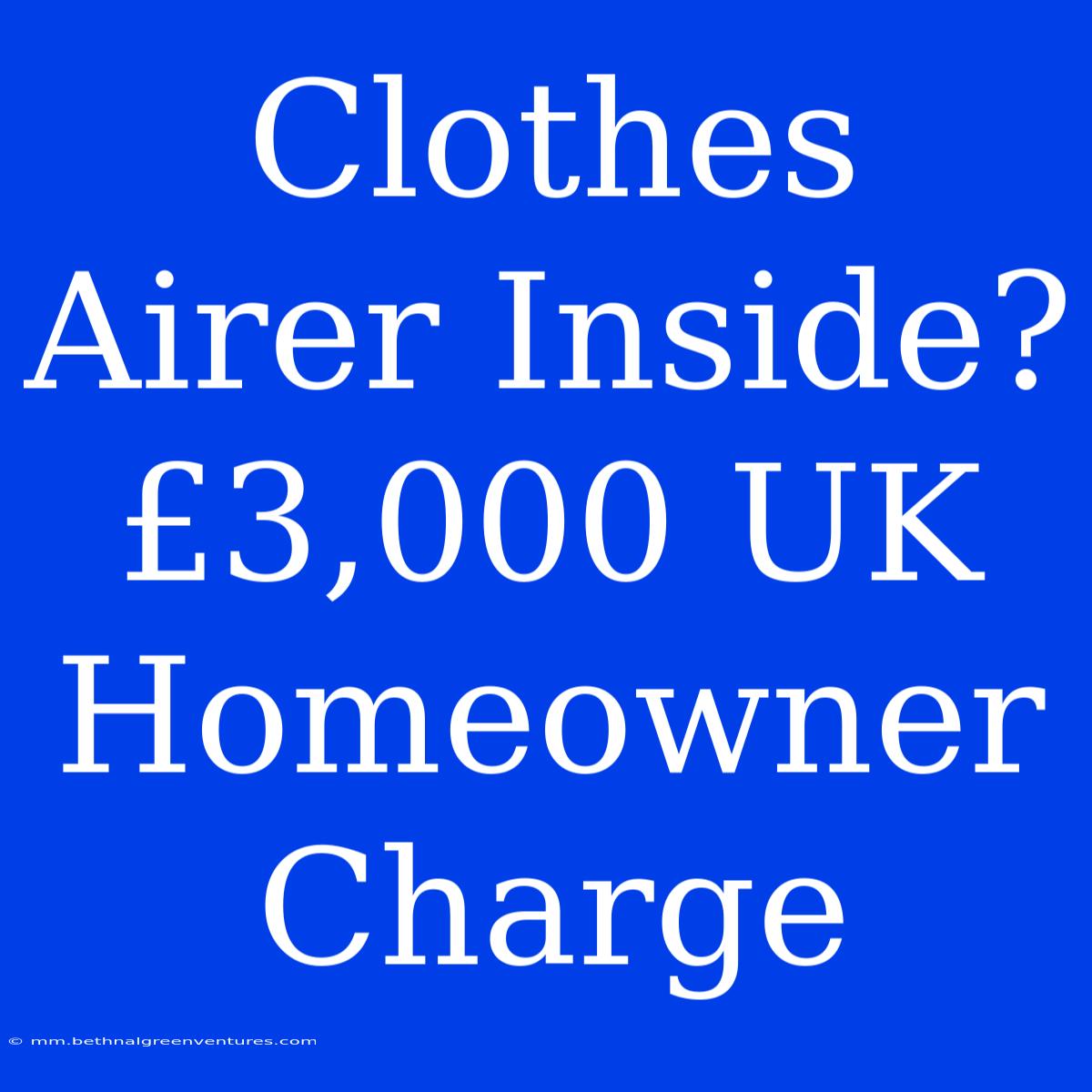Clothes Airer Inside? £3,000 UK Homeowner Charge - A Shocking New Development
Is a clothes airer inside your home really a £3,000 charge waiting to happen? This recent development in UK housing regulations has shocked homeowners across the country. Editor Note: The news of a potential £3,000 charge for indoor clothes airers has been met with disbelief and concern.
Understanding the reasons behind this proposed charge and its implications is crucial for homeowners. The change reflects a growing focus on energy efficiency and minimizing carbon emissions in the UK, a goal supported by many. But the practical application and potential consequences of this policy have sparked heated debate.
Our Analysis: This article examines the latest information surrounding this controversial regulation. We've delved into the arguments for and against the charge, considering its impact on homeowners, the broader energy efficiency landscape, and the potential alternatives.
Key Takeaways:
| Key Aspect | Description |
|---|---|
| Proposed Charge: A £3,000 fine may be imposed on homeowners who use indoor clothes airers to dry their laundry. | |
| Energy Efficiency: The policy aims to reduce carbon emissions by promoting the use of energy-efficient drying methods like tumble dryers. | |
| Homeowner Impact: The charge could significantly impact homeowners, particularly those with limited budgets or who rely on indoor drying due to space constraints. |
Indoor Clothes Airers
The debate revolves around the use of indoor clothes airers, a common practice in the UK, particularly during colder months. This practice, however, is now being scrutinized for its energy inefficiency.
Energy Efficiency and Indoor Drying
- High Humidity: Indoor clothes airers increase humidity levels, potentially causing condensation, mold growth, and respiratory issues.
- Energy Consumption: While initially seen as energy-efficient compared to tumble dryers, indoor airers can contribute to higher heating costs.
- Alternative Drying Methods: Energy-efficient tumble dryers and outdoor drying, when weather permits, are presented as better solutions.
Impact on Homeowners:
- Financial Burden: The £3,000 charge can be a substantial financial burden for homeowners, particularly those on fixed incomes or with limited savings.
- Disproportionate Impact: This policy may disproportionately affect certain demographics, such as low-income families, those living in smaller homes, and those with health conditions requiring specific laundry care.
- Practical Limitations: Many homeowners, due to space constraints, weather conditions, or other limitations, may find it impractical to switch to alternative drying methods.
Solutions and Alternatives:
- Improved Ventilation: Ensuring proper ventilation can mitigate humidity concerns associated with indoor drying.
- Energy-Efficient Drying Methods: Promoting the use of energy-efficient tumble dryers and providing incentives for their purchase can be more effective than penalizing indoor airers.
- Targeted Solutions: Focusing on solutions tailored to specific needs, considering factors like home size, climate, and individual circumstances, is crucial.
FAQ:
Q: Why is there a charge for using indoor clothes airers?
A: The proposed charge aims to promote energy efficiency and reduce carbon emissions by encouraging homeowners to adopt alternative laundry drying methods.
Q: How much is the potential charge?
A: The proposed charge is currently set at £3,000 for homeowners who use indoor clothes airers.
Q: Who is affected by this regulation?
A: All homeowners who use indoor clothes airers are potentially subject to the charge, although the final implementation and enforcement details are still being discussed.
Q: What are the alternatives to indoor drying?
A: Energy-efficient tumble dryers, outdoor drying (weather permitting), and improved ventilation are suggested alternatives to indoor clothes airers.
Q: What can homeowners do to avoid the charge?
A: Homeowners can explore alternative drying methods, improve ventilation, and stay informed about the latest updates and potential exemptions to the regulation.
Tips for Managing Laundry Drying:
- Invest in an energy-efficient tumble dryer: Explore models with features like heat pump technology, which uses less energy.
- Maximize outdoor drying: Utilize sunny days for outdoor drying whenever possible.
- Improve ventilation: Ensure adequate ventilation in your laundry room and home to prevent moisture build-up.
- Consider drying racks: Use drying racks within your home to dry smaller items or delicates.
- Be informed: Stay up-to-date on any changes to the regulations and potential exemptions.
Conclusion: The proposed charge on indoor clothes airers in the UK highlights the complex relationship between energy efficiency, cost-effectiveness, and individual needs. While aiming for a greener future, it's crucial to ensure that the policy's implementation is fair, practical, and considers the diverse needs of homeowners.
This regulation is a reminder of the ever-evolving landscape of energy policy and the need for open dialogue and effective solutions that promote sustainability without overburdening individuals.
